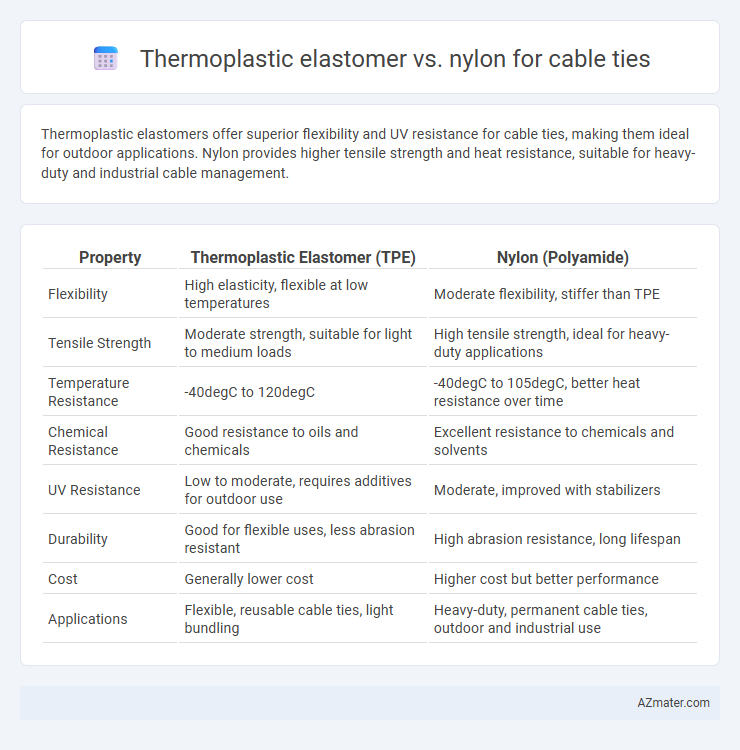Thermoplastic elastomers offer superior flexibility and UV resistance for cable ties, making them ideal for outdoor applications. Nylon provides higher tensile strength and heat resistance, suitable for heavy-duty and industrial cable management.
Table of Comparison
| Property | Thermoplastic Elastomer (TPE) | Nylon (Polyamide) |
|---|---|---|
| Flexibility | High elasticity, flexible at low temperatures | Moderate flexibility, stiffer than TPE |
| Tensile Strength | Moderate strength, suitable for light to medium loads | High tensile strength, ideal for heavy-duty applications |
| Temperature Resistance | -40degC to 120degC | -40degC to 105degC, better heat resistance over time |
| Chemical Resistance | Good resistance to oils and chemicals | Excellent resistance to chemicals and solvents |
| UV Resistance | Low to moderate, requires additives for outdoor use | Moderate, improved with stabilizers |
| Durability | Good for flexible uses, less abrasion resistant | High abrasion resistance, long lifespan |
| Cost | Generally lower cost | Higher cost but better performance |
| Applications | Flexible, reusable cable ties, light bundling | Heavy-duty, permanent cable ties, outdoor and industrial use |
Introduction: Thermoplastic Elastomer vs Nylon Cable Ties
Thermoplastic elastomer (TPE) cable ties offer superior flexibility and chemical resistance compared to nylon, making them ideal for applications requiring frequent repositioning or exposure to harsh environments. Nylon cable ties provide high tensile strength and thermal stability, which ensures durability under heavy loads and elevated temperatures. Selecting between TPE and nylon depends on specific needs such as elasticity, environmental exposure, and load-bearing capacity.
Material Composition and Properties
Thermoplastic elastomers (TPE) for cable ties consist of a blend of thermoplastics and elastomers, offering flexibility, elasticity, and resistance to UV rays and chemicals, making them ideal for applications requiring repeated bending or vibration absorption. Nylon, primarily composed of polyamide polymers, delivers superior tensile strength, abrasion resistance, and thermal stability, ensuring durability and high performance in harsh or high-temperature environments. The choice between TPE and Nylon depends on the need for flexibility versus strength, with TPE favored for softer, more pliable ties and Nylon preferred for heavy-duty, long-lasting cable management solutions.
Strength and Durability Comparison
Thermoplastic elastomer (TPE) offers excellent flexibility and moderate tensile strength, making it suitable for applications requiring repeated bending without cracking. Nylon cable ties, particularly Nylon 6/6, exhibit superior tensile strength and higher resistance to wear, abrasion, and environmental factors such as UV exposure and chemicals, contributing to their greater long-term durability. For heavy-duty applications demanding maximum strength and longevity, nylon is generally preferred over TPE due to its enhanced mechanical properties and thermal stability.
Flexibility and Elasticity Differences
Thermoplastic elastomers (TPE) offer superior flexibility and elasticity compared to nylon when used in cable ties, allowing them to stretch and return to their original shape without deformation. Nylon cable ties exhibit higher tensile strength but are less flexible and more prone to permanent deformation under repeated bending or stretching. The elasticity of TPE makes it ideal for applications requiring frequent adjustments, while nylon provides durability for static, high-strength bundling.
Environmental Resistance: UV, Chemicals, and Moisture
Thermoplastic elastomers (TPE) exhibit superior environmental resistance compared to nylon, particularly in UV stability, chemical resistance, and moisture absorption. TPE maintains flexibility and strength when exposed to prolonged UV exposure and resists degradation from a wide range of chemicals, making it ideal for outdoor and industrial applications. Nylon tends to absorb moisture, which can compromise its mechanical properties and reduce performance in humid or wet environments.
Temperature Tolerance and Performance
Thermoplastic elastomer (TPE) offers excellent flexibility and maintains performance in temperatures ranging from -40degC to 125degC, making it suitable for environments requiring elasticity and repeated bending. Nylon cable ties, typically made from Nylon 6/6, provide superior mechanical strength and chemical resistance, with temperature tolerance generally between -40degC and 85degC, suitable for applications involving heat exposure and heavy-duty securing. For applications demanding higher temperature resistance and durability, Nylon outperforms TPE, while TPE excels in flexible, low-temperature environments.
Ease of Installation and Handling
Thermoplastic elastomer (TPE) cable ties offer superior flexibility and elasticity, making them easier to install and handle in tight or irregular spaces compared to nylon ties. Nylon cable ties provide high tensile strength but can be stiffer, which may require more effort during installation, especially in applications needing frequent adjustments or repositioning. The enhanced pliability of TPE reduces hand fatigue and improves grip, optimizing efficiency in repetitive or complex cable management tasks.
Cost Analysis and Value Considerations
Thermoplastic elastomers (TPE) generally offer a lower upfront cost compared to nylon for cable tie production, making them attractive for budget-sensitive applications. Nylon cable ties provide superior strength, durability, and resistance to chemicals and UV exposure, often justifying the higher cost through extended lifespan and reliability. When evaluating cost versus value, nylon's long-term performance benefits typically outweigh initial expenses, whereas TPE suits short-term or less demanding uses where cost-efficiency is crucial.
Common Applications for Each Material
Thermoplastic elastomer (TPE) cable ties are commonly used in automotive and electronics industries for securing wiring harnesses due to their flexibility, chemical resistance, and vibration damping properties. Nylon cable ties are favored in construction, agriculture, and general industrial applications for their high tensile strength, durability, and UV resistance. Both materials offer distinct advantages, with TPE suited to environments requiring elasticity and Nylon preferred where strength and long-term exposure to elements are critical.
Choosing the Right Material for Your Cable Tie Needs
Thermoplastic elastomer (TPE) offers excellent flexibility and chemical resistance, making it ideal for applications requiring repeated bending and environmental exposure. Nylon provides superior tensile strength and heat resistance, suitable for heavy-duty and high-temperature cable fastening. Selecting the right material hinges on specific needs such as flexibility, durability, and environmental conditions to ensure optimal performance and longevity of cable ties.

Infographic: Thermoplastic elastomer vs Nylon for Cable tie
 azmater.com
azmater.com